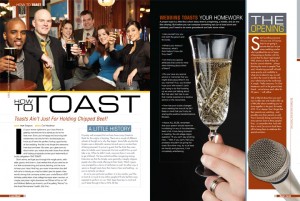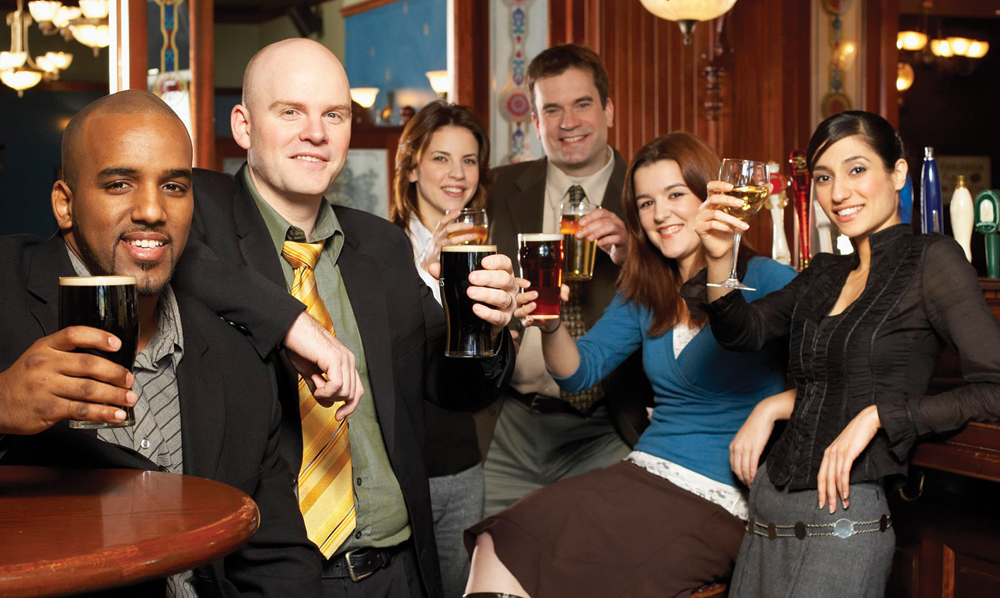How To Toast–Toasts Ain’t Just For Holding Chipped Beef!
words: Matt Simpson photos: Carl Hyndman
Article from the May/Jun 2008 Issue of Beer Magazine

It’s your worst nightmare: your best friend is getting married and he’s asked you to be his best man. Sure, you’re happy and bouncing with excitement, not only for him, but because you know you’ll have the perfect hookup opportunity at the wedding. And let’s not forget the awesome free food and beer. But alas, your glee turns to shock when you realize that with those free drinks and hookup prospects comes your best-manly or buddy obligation—THE TOAST!
Don’t worry, we’ll get you through the rough parts…with style, grace, and charm. Just realize that all you need to do is a little soul-searching and some planning, and be sure to keep your head. And hey, you never know when this skill will come in handy; you may be called upon to speak a few words during that company soirée, your uncle Bosco’s 65th birthday celebration, that college lacrosse team reunion, or maybe just poker night downtown at O’Brien’s Pub on 14th and Walnut. Before you know it, you’ll be yelling “Noroc!” to the finest Romanians’ health. But first…

A Little History
It’s pretty well accepted that we have those crazy Greeks to thank for the origins of toasting. There are a couple of different schools of thought as to why they began. Some folks say that the Greeks were a distrustful, anxious lot and were in constant fear of being poisoned. To prove to guests that the drink they were about to imbibe wasn’t poisoned, the host would lift his up and take a sip. When he didn’t croak, everyone knew it was safe to get shitfaced. The less morbid and fear mongering among historians say that the Greeks were generally a deeply religious people who often made offerings to their Gods. Which I guess was prompted by a terror of retribution as well. So either way, it seems as though toasts have their basis in fear and loathing…so you’re certainly not alone!
So on to your particular problem. In a few months, you’ll be in front of a crowd of one million people (it’ll only feel that way), expected to perform on cue. Well, keep these tips in mind and you’ll skate through it like an NHL All Star.
Wedding Toasts Your Homework
A proper toast is a little like a short story; there’s a beginning, a middle, and an end (the closing). But before you can compose something epic (or at least short and painless), you’ll need to do some groundwork and take some notes:
• Ask yourself how you met both the groom and the bride.
• What’s your history? Moreover, what’s their history? How did they meet?
• Are there any special attributes that come to mind when thinking about either of them?
• Do you have any special advice or memories that you might share about them? Are you married? If so, you’d better hope your wife doesn’t catch you trying to do that hooking up we were just talking about. But that said, feel free to use that marital experience to bestow advice on the newlyweds.
• How has your buddy changed since meeting the love of his life? Keep in mind that you’ll only be sharing the positive transformations, Einstein.
• Above ALL ELSE, remember that your speech should never be humiliating for any of the attendees…least of all, those being honored. In toasting, the old adage reigns supreme: “If you can’t say anything nice…” Well, if you can’t, then you probably shouldn’t be giving the toast. But either way, try to at least be friendly and gracious, if not completely entertaining.

The Opening
Start by telling everyone who you are. Of course, they’re not going to assume that you’re just some wedding-crasher who’s grabbed the mic in hopes of becoming so familiar with the crowd that he doesn’t get booted. Well, shame on them if they do. Buncha cynical relatives…always thinking the worst in people! That said, introducing yourself will add some gravity and credibility to what you’re about to say, as well as allow the crowd to identify with your relationship to the newlyweds. A simple, “Hello everyone, I’m Chet Masterson and I’m the groom’s best friend…we’ve known each other for 20 years…” will suffice.
Talk a little bit about how you and your buddy met, and maybe offer up a little joke about something you’ve done together in the past. But make it PG-13 or cleaner. Don’t forget that their parents are watching…and possibly even their parents as well. You’re basically being examined by every person close to these peoples’ lives…so remember that. And with that in mind, be sure to thank them all for being there to celebrate this special occasion.
The Heart of the Matter
After you’ve introduced yourself, thanked everyone for being there, and explained how your manly bond with the groom or honoree was forged over time, you’ll want to share a little tale, joke, or anecdote that proves you guys have seen it all. But here are some pointers:

1. If it’s a wedding, try to include the bride in one or two of your stories or jokes. It’s not an exclusively groom invited crowd or event, don’t forget.
2. Don’t ramble on forever. Keep it relatively short and on point, or everyone in the joint will be snoozing in their Sierra Nevadas.
3. Did I already mention that you should never say anything offensive or mortifying? I did, right? That’s how important that lesson is. It bears repeating. The last thing you want is to alienate yourself from both families, forever (trust me…they won’t ever forget it), because of one drunk, retarded moment. Needless to say, stories about either of their exes are out, Sunshine.
Bring it All Around
After you’ve spoken about your personal relationships with the groom and the bride as individuals, it’s time to honor them together as a couple. Speak briefly about what’s brought them together, made them the special pair they are, and how those will be the things that keep them together for life. If you’re toasting someone other than a wedded duo, simply chat
about what makes the honoree so unique and deserving of the crowd’s adoration
and attendance.

With that, raise your full glass and instruct all in attendance to do the same. Then, with a heartfelt, firm voice, wish a cheer to the welfare, long relationship, and/or life to the couple or honoree. Feel free to end with a “Cheers,” in the language of your choice…see below for some examples. We’ve also included a few classic, traditional toasts. You’re welcome to use one of them in your closing. But if you do, you have to promise to mention Beer magazine at the end.
Traditional Wedding Toasts:
“May you both live as long as you want, and never want as long as you live.”
“May the saddest day of your future be no worse than the happiest day of your past.”
“May your love be modern enough to survive the times
and old fashioned enough to last forever.”
“May the saints protect you and sorrow neglect you, and bad luck to the one that doesn’t respect you”
“May your wedding days be few and your anniversaries many.”
Other Traditional Toasts:
“May you have warm words on a cold evening, a full moon on a dark night, and the road downhill all the way to your door.”
“May you all live to be 100 years, and me 100 minus a day, so that I don’t know that good people like you have passed.”
“May your troubles be less and your blessings be more. And nothing but happiness come through your door.”
“May you have food and raiment, a soft pillow for your head, may you be forty years in heaven before the devil knows you’re dead.”
“Here’s to our wives and lovers. May they never meet.” (Ok, this one’s best saved for the guys.)
Toasting Around the World
Afrikaans -“Gesondheid”
Albanian “Shëndeti tuaj”
Arabic “Fi sahitak”
Armenian “Genatset”
Asturian “Gayola”
Austrian “Prost” / “Zum Wohl”
Azerbaijani “Afiyæt oslun”
Basque “Topa”
Belgian Op uw gezonheid
Bengali “Joy”
Bosnian “Zivjeli”
Brazilian “Saude”
Breton “Yec’hed mat”
Bulgarian “Nazdrave”
Catalan “Salut”
Chinese “Kong chien”
Cornish “Yeghes da”
Creole “Salud”
Croatian “Zivjeli” / “U zdravlje”
Czech “Na zdraví”
Danish “Skål”
Dutch “Proost”
Egyptian “Fee sihetak”
Esperanto “Sanon”
Estonian “Teie terviseks”
Farsi “Ba’sal’a’ma’ti”
Finnish “Kippis”
French “À votre santé / Santé”
Frisian “Tsjoch”
Galician “Chinchín” / “Saúde”
German “Prost”
Greek “Gia’sou”
Greenlandic “Kasugta”
Hawaiian “Hipahipa”
Hebrew “Le’chaim”
Hindi “Apki Lambi Umar Ke Liye”
Holooe “Kam-poe”
Hungarian “Egészségedre”
Icelandic “Santanka nu” / “Skål”
Ido “Ye vua saneso”
Irish Gaelic “Sláinte 1”
Italian “Salute” / “Cin cin”
Japanese “Kampai”
Korean “Konbe”
Latin “Sanitas bona” / “Bene tibi”
Latvian “Prieka”
Lithuanian “I sveikata”
Malaysian “Minum”
Mandarin “Gan bei”
Mexican “Salud”
Moroccan “Saha wa’afiab”
Norwegian “Skål”
Occitan “A la vòstra”
Pakistani “Sanda bashi”
Philippine “Mabuhay”
Polish “Na zdrowie”
Portuguese “Saúde”
Rumanian “Noroc”
Russian “Vashe zdorovie”
Serbian “Zivjeli” / “U zdravlje”
Sesotho “Nqa”
Slovak “Na zdravie”
Slovenian “Na zdravje”
Spanish “Salud”
Swahili “Afya” / “Vifijo”
Swedish “Skål”
Tagalog “Mabuhay”
Thai “Chook-die” / “Sawasdi”
Turkish “Serefe”
Ukrainian “Na zdorov’ya”
Welsh “Iechyd da”
Yiddish “Lechaim”
Yugoslavian “Ziveo” / “Ziveli”
Zulu “Oogy wawa”
* Courtesy, Webtender (www.webtender.com)




